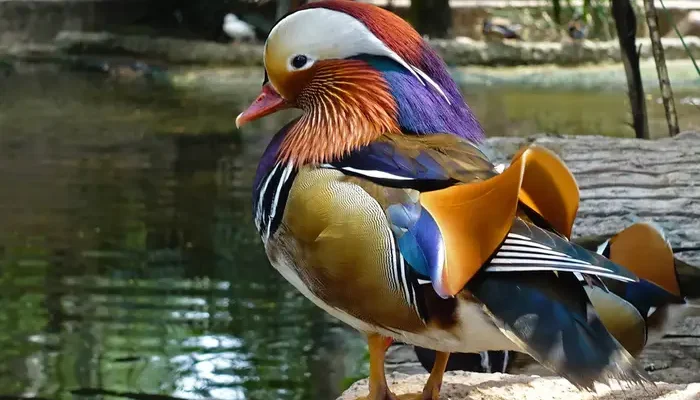The animal kingdom is full of beauty. From their vibrant feathers to majestic fur coats, there’s no denying that some animals are just prettier than us humans.
But don’t get down on yourself for not being as cute as a poison dart frog or as stunning as an Arctic fox. There are reasons why these critters are so gorgeous — most have to do with evolution.
Here are 10 good-looking animals and the science behind their beauty.
The blue glaucus is the prettiest slug in the sea.
The blue glaucus, otherwise known as a blue dragon sea slug, is probably the prettiest slug on Earth. With wacky, striped tendrils and a vibrant body, the blue glaucus is eye-catching.
But their blue coloring is a form of sneaky camouflage to protect the creatures while they float through the open ocean. When predators in the sky look down, they can’t spot the sea slugs, since they blend right into the shimmering sea. And when predators in the water below look up, they see the opposite side of the slug, which is gray and hard to detect.
The handsome male mandarin duck uses its plumes to attract female ducks.
There was a lot of buzz about these fancy waterfowl after one took up residence in Central Park this fall. Originally from east Asia, the mandarin duck has found its way around the world, delighting park-goers with its beautiful plumes.
Mandarin ducks are sexually dimorphic, which means the males and females don’t look the same. Male mandarin ducks have the bright striped feathers, while female ducks are brown with white spots. The males use their attention-grabbing colors to attract a mate. But once summer rolls around, he molts and loses his come-hither feathers.
Tiny, adorable poison dart frogs can kill fully grown men.
The tiny poison dart frog comes in a rainbow of colors and can be found in South American rainforests. The elaborate patterns on the backs of the 1-inch amphibians can have shades of blue, red, yellow, or black. They’re meant to steer predators away.
In this species, the male frog cares for the young. After the female lays eggs, the male carries them around on his back all way through their tadpole stage.
If you come across of these creatures, keep a safe distance. Poison dart frogs contain enough poison to kill 10 adult men.
The female orchid mantis is pretty in pink.
The mantis’ evolution in Southeast Asia led the female praying mantis to resemble beautiful orchid flowers.
That’s because the females hunt near the flowers. Their appearance fools pollinating bugs into getting close to them, and once the bugs are within reach, the orchid mantis quickly gobbles them up.
There’s no question that the orchid mantis looks like its namesake. Its soft pink and white tones and delicate striped patterns make it look nearly identical to the flower.
Arctic foxes’ majestic coats camouflage them in the snow.
With the sweet face of a puppy and a luscious white fur coat, Arctic foxes are certainly cute. But that pristine coat isn’t just for show. The thick fur that covers their body and paws helps them regulate their heat so they can survive in the frigid temperatures of Canada, Russia, Scandinavia, and other cold northern countries.
The distinct white fur is also effective camouflage in the snow. During the winter, Arctic foxes fit right into their habitats on the frozen tundra. Then when the snow melts, the foxes develop a gray coat that blends with the new plants and rocks that appear in the summer.
Gorgeous green-headed tanagers blend right into the lush forest.
Covered in green, turquoise, and black feathers, the green-headed tanager hails from the forests of Brazil. The birds typically stick together in small groups of 10 to 20.
While their bright colors would attract attention in other circumstances, the green-headed tanager actually blends right into its environment. The vibrant green leaves covering the Brazilian forests are a perfect match to the greens on this beautiful bird.
Mandarinfish aren’t just pretty — they’re also deadly.
The beautiful blue-striped Mandarinfish is found in the Pacific ocean from Japan down to Australia.
Most blue-colored animals don’t naturally produce their own pigment — typically, blue animals rely on an optical illusion using light. But the Mandarinfish is an exception, since it has special chromatophores called cyanophores that contain blue pigment.
These flamboyant fish are also poisonous and smell terrible. Because these fish don’t have any scales, they need extra protection from predators. So their bodies are covered in toxic spines and coated by a thick, foul-smelling mucus. Between the deadly poison and the gross smell, other animals know to leave these beauties alone.
Panther chameleons switch up their look based on their mood.
Shutterstock
The panther chameleon’s vast range of colors makes it one of the planet’s prettiest animals.
When you see chameleons in cartoons that can change colors in the blink of the eye, that’s most likely a reference to one of these pretty lizards. But the panther chameleon’s color changes don’t happen the way most people think.
If you change the background behind the lizard, for example, it might not switch hues. Instead, chameleons change colors for a variety of reasons including to communicate and express emotion. They do also sometimes use that ability to better blend into their natural habitat.
The clouded leopard looks like an exotic house cat.
Not only does this big cat have a beautiful, celestial name, but its big, brown eyes seem almost tender. A relatively small wild cat, the clouded leopard has unique spots and purrs like a house cat.
Those unique spots help it blend into its rainforest habitat in Southeast Asia. The way light filters through the treetops resembles the markings on the clouded leopard, which gives this big cat a chance to sneak up on its prey.
The sunset moth’s iridescent wings reflect bright light.
These rainbow beauties are exclusively found on the island of Madagascar, where they feed on the nectar of flowers.
The sunset moth stands out because of the unique, colorful patterns on its wings. These bright colors signal to predators that the sunset moth is poisonous and not to be messed with.
The iridescence of the sunset moth’s wings is what causes it to look so vibrant. In darker light, the moth appears dull, since there is hardly any pigment in its wings. But bright light sets the colors of the wings aflame, revealing bright reds, oranges, and greens.



